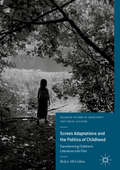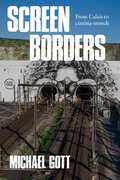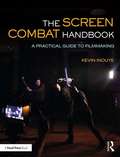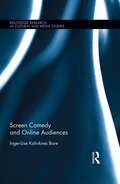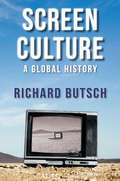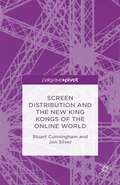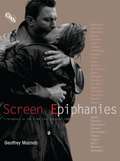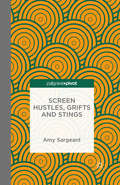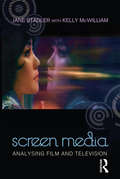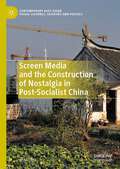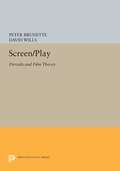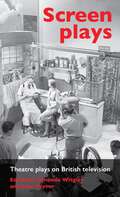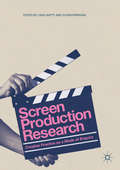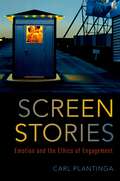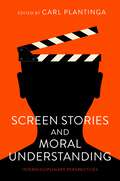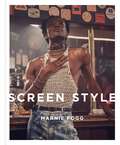- Table View
- List View
Screen Adaptations and the Politics of Childhood: Transforming Children's Literature into Film (Palgrave Studies in Adaptation and Visual Culture)
by Robyn McCallumThis book features a cutting edge approach to the study of film adaptations of literature for children and young people, and the narratives about childhood those adaptations enact. Historically, film media has always had a partiality for the adaptation of ‘classic’ literary texts for children. As economic and cultural commodities, McCallum points out how such screen adaptations play a crucial role in the cultural reproduction and transformation of childhood and youth, and indeed are a rich resource for the examination of changing cultural values and ideologies, particularly around contested narratives of childhood. The chapters examine various representations of childhood: as shifting states of innocence and wildness, liminality, marginalisation and invisibility. The book focuses on a range of literary and film genres, from ‘classic’ texts, to experimental, carnivalesque, magical realist, and cross-cultural texts.
Screen borders: From Calais to <i>cinéma-monde</i>
by Michael GottFilm and television offer important insights into social outlooks on borders in France and Europe more generally. This book undertakes a visual cultural history of contemporary borders through a film and television tour. It traces on-screen borders from the Gare du Nord train station in Paris to Calais, London, Lampedusa and Lapland. It contends that different types of mobilities and immobilities (refugees, urban commuters, workers in a post-industrial landscape) and vantage points (from borderland forests, ports, train stations, airports, refugee centers) are all part of a complex French and European border narrative. It covers a wide range of examples, from popular films and TV series to auteur fiction and documentaries by well-known directors from across Europe and beyond.
Screen borders: From Calais to <i>cinéma-monde</i>
by Michael GottFilm and television offer important insights into social outlooks on borders in France and Europe more generally. This book undertakes a visual cultural history of contemporary borders through a film and television tour. It traces on-screen borders from the Gare du Nord train station in Paris to Calais, London, Lampedusa and Lapland. It contends that different types of mobilities and immobilities (refugees, urban commuters, workers in a post-industrial landscape) and vantage points (from borderland forests, ports, train stations, airports, refugee centers) are all part of a complex French and European border narrative. It covers a wide range of examples, from popular films and TV series to auteur fiction and documentaries by well-known directors from across Europe and beyond.
The Screen Combat Handbook: A Practical Guide for Filmmakers
by Kevin InouyeThe Screen Combat Handbook is an essential guide to navigating the unique challenges of putting combat on screen. Explore the process from the early stages of preproduction planning all the way through to editing and sound design, and everything in-between. This book uses practical instruction, examples, interviews, and illustrations to show how to plan, shoot, and assemble safe and effective fight sequences. It includes sections on thoughtful and practical design choices in set, wardrobe, props, and effects, preproduction planning, on-set protocol, fight choreography and coordination, shot planning and technical tricks, acting choices, effective cinematography, and impactful editing and sound design. It provides an invaluable resource for all those involved including directors, fight coordinators, actors and stunt players, and any filmmaker attempting to shoot an exciting action scene safely. Whether working on a no-budget indie production or on a professional set, this is your ultimate guide to screen combat and fight choreography.
The Screen Combat Handbook: A Practical Guide for Filmmakers
by Kevin InouyeThe Screen Combat Handbook is an essential guide to navigating the unique challenges of putting combat on screen. Explore the process from the early stages of preproduction planning all the way through to editing and sound design, and everything in-between. This book uses practical instruction, examples, interviews, and illustrations to show how to plan, shoot, and assemble safe and effective fight sequences. It includes sections on thoughtful and practical design choices in set, wardrobe, props, and effects, preproduction planning, on-set protocol, fight choreography and coordination, shot planning and technical tricks, acting choices, effective cinematography, and impactful editing and sound design. It provides an invaluable resource for all those involved including directors, fight coordinators, actors and stunt players, and any filmmaker attempting to shoot an exciting action scene safely. Whether working on a no-budget indie production or on a professional set, this is your ultimate guide to screen combat and fight choreography.
Screen Comedy and Online Audiences (Routledge Research in Cultural and Media Studies)
by Inger-Lise Kalviknes BoreThe question of why we laugh (or don't laugh) has intrigued scholars since antiquity. This book contributes to that debate by exploring how we evaluate screen comedy. What kinds of criteria do we use to judge films and TV shows that are meant to be funny? And what might that have to do with our social and cultural backgrounds, or with wider cultural ideas about film, TV, comedy, quality and entertainment? The book examines these questions through a study of audience responses posted to online facilities such as Twitter, Facebook, review sites, blogs and message boards. Bore’s analysis of these responses considers a broad range of issues, including how audiences perceive the idea of "national" comedy; what they think of female comedians; how they evaluate romcoms, sitcoms and web comedy; what they think is acceptable to joke about; what comedy fans get excited about; how fans interact with star comedians; and what comedy viewers really despise. The book demonstrates some of the ways in which we can adapt theories of humour and comedy to examine the practices of contemporary screen audiences, while offering new insights into how they negotiate the opportunities and constrictions of different online facilities to share their views and experiences.
Screen Comedy and Online Audiences (Routledge Research in Cultural and Media Studies)
by Inger-Lise Kalviknes BoreThe question of why we laugh (or don't laugh) has intrigued scholars since antiquity. This book contributes to that debate by exploring how we evaluate screen comedy. What kinds of criteria do we use to judge films and TV shows that are meant to be funny? And what might that have to do with our social and cultural backgrounds, or with wider cultural ideas about film, TV, comedy, quality and entertainment? The book examines these questions through a study of audience responses posted to online facilities such as Twitter, Facebook, review sites, blogs and message boards. Bore’s analysis of these responses considers a broad range of issues, including how audiences perceive the idea of "national" comedy; what they think of female comedians; how they evaluate romcoms, sitcoms and web comedy; what they think is acceptable to joke about; what comedy fans get excited about; how fans interact with star comedians; and what comedy viewers really despise. The book demonstrates some of the ways in which we can adapt theories of humour and comedy to examine the practices of contemporary screen audiences, while offering new insights into how they negotiate the opportunities and constrictions of different online facilities to share their views and experiences.
Screen Culture: A Global History (New Directions in Media History)
by Richard ButschIn this expansive historical synthesis, Richard Butsch integrates social, economic, and political history to offer a comprehensive and cohesive examination of screen media and screen culture globally – from film and television to computers and smart phones – as they have evolved through the twentieth and twenty-first centuries. Drawing on an enormous trove of research on the USA, Britain, France, Egypt, West Africa, India, China, and other nations, Butsch tells the stories of how media have developed in these nations and what global forces linked them. He assesses the global ebb and flow of media hegemony and the cultural differences in audiences' use of media. Comparisons across time and space reveal two linked developments: the rise and fall of American cultural hegemony, and the consistency among audiences from different countries in the way they incorporate screen entertainments into their own cultures. Screen Culture offers a masterful, integrated global history that invites media scholars to see this landscape in a new light. Deeply engaging, the book is also suitable for students and interested general readers.
Screen Distribution and the New King Kongs of the Online World
by Stuart Cunningham Jon SilverDrawing on comparisons with historical shake-ups in the film industry, Screen Distribution Post-Hollywood offers a timely account of the changes brought about in global online distribution of film and television by major new players such as Google/YouTube, Apple, Amazon, Yahoo!, Facebook, Netflix and Hulu.
Screen Epiphanies: Film-makers on the films that inspired them
by Geoffrey Macnab'What I remember was that it was the first time a piece of fiction had had such a devastating emotional effect on me. A lot of children remember seeing cartoons, Pinocchio or Bambi or something that breaks their heart. I remember seeing The Blue Angel and it breaking my heart. It was the first time I realised there was an adult world - that adults could damage each other or destroy each other emotionally. It might have fed into a whole series of epiphanies about my own upbringing. I was living in a family where my grandparents had separated in quite complex circumstances. Perhaps it resonated with some elements of that, to do with simply how love can be a rupturing and damaging emotion as well as a healing one. Also, to see somebody who is in an authority position made so small, so diminished, by the feeling of having no control.' Anthony Minghella / The Blue Angel 'In a strange, lethal way, I was suddenly wildly attracted to the process of filmmaking, even though it is described as a nightmare - a matter of horror - in that film. There is a trancelike atmosphere. Suddenly, I was reminded that you can feel like it's a matter of life and death when you make a film. It changed from being a mediocre feeling of emptiness in your life to something that feels necessary. I realised that filmmaking can be many things - and it can be narcotic in a way. You can become addicted to it.' Thomas Vinterberg / Hearts of Darkness Screen Epiphanies brings together 32 leading film-makers to discuss the films that inspired them to pursue a career in the movie business, or which influenced their own film-making practice, or which stayed with them because of their depictions of familiar communities, intense human relationships or unknown worlds. Beautifully illustrated with images from the films discussed, Screen Epiphanies is a thought-provoking and often moving insight into the creative process and the way in which artists are inspired by each other's work, but also into the centrality of cinema in all our lives, and its power to change our ambitions and how we see the world around us.
Screen Epiphanies: Film-makers on the films that inspired them
by Geoffrey Macnab'What I remember was that it was the first time a piece of fiction had had such a devastating emotional effect on me. A lot of children remember seeing cartoons, Pinocchio or Bambi or something that breaks their heart. I remember seeing The Blue Angel and it breaking my heart. It was the first time I realised there was an adult world - that adults could damage each other or destroy each other emotionally. It might have fed into a whole series of epiphanies about my own upbringing. I was living in a family where my grandparents had separated in quite complex circumstances. Perhaps it resonated with some elements of that, to do with simply how love can be a rupturing and damaging emotion as well as a healing one. Also, to see somebody who is in an authority position made so small, so diminished, by the feeling of having no control.' Anthony Minghella / The Blue Angel 'In a strange, lethal way, I was suddenly wildly attracted to the process of filmmaking, even though it is described as a nightmare - a matter of horror - in that film. There is a trancelike atmosphere. Suddenly, I was reminded that you can feel like it's a matter of life and death when you make a film. It changed from being a mediocre feeling of emptiness in your life to something that feels necessary. I realised that filmmaking can be many things - and it can be narcotic in a way. You can become addicted to it.' Thomas Vinterberg / Hearts of Darkness Screen Epiphanies brings together 32 leading film-makers to discuss the films that inspired them to pursue a career in the movie business, or which influenced their own film-making practice, or which stayed with them because of their depictions of familiar communities, intense human relationships or unknown worlds. Beautifully illustrated with images from the films discussed, Screen Epiphanies is a thought-provoking and often moving insight into the creative process and the way in which artists are inspired by each other's work, but also into the centrality of cinema in all our lives, and its power to change our ambitions and how we see the world around us.
Screen Hustles, Grifts and Stings: Stings, Grifts, Hustles and the Long Con
by A. SargeantScreen Hustles, Grifts and Stings identifies recurrent themes and techniques of the con film, suggests precedents in literature and discusses the perennial appeal of the con man for readers and viewers alike. Core studies span from film (Catch Me If You Can, Paper Moon, House of Games) to television (Hustle), from Noir (The Grifters) to Romantic Comedy (Gambit). Frequently, the execution of the con is only finely distinguishable from the conduct of a legitimate profession and, challengingly, a mark is often shown to be culpable in his or her undoing. The best con films, it is suggested, invite re-watching and reward the viewer accordingly: who is complicit and when? How and where is the con achieved? When is the viewer party to the con? And what, if any, moral is to be drawn?
Screen Media: Analysing Film and Television
by Jane Stadler Kelly McWilliamScreen Media offers screen enthusiasts the analytical and theoretical vocabulary required to articulate responses to film and television. The authors emphasise the importance of 'thinking on both sides of the screen'. They show how to develop the skills to understand and analyse how and why a screen text was shot, scored, and edited in a particular way, and then to consider what impact those production choices might have on the audience.Stadler and McWilliam set production techniques and approaches to screen analysis in historical context. They demystify technological developments and explain the implications of increasing convergence of film and television technologies. They also discuss aesthetics, narrative, realism, genre, celebrity, cult media and global screen culture. Throughout they highlight the links between screen theory and creative practice.With extensive international examples, Screen Media is an ideal introduction to critical engagement with film and television.'Screen Media offers a systematic approach to film and television analysis. The examples chosen by the authors are both appropriate and timely, and are presented in a very lively and readable form that will appeal to an international readership.' - Rebecca L. Abbott, Professor of Film, Video + Interactive Media, Quinnipiac University, USA
Screen Media: Analysing Film and Television
by Jane Stadler Kelly McWilliamScreen Media offers screen enthusiasts the analytical and theoretical vocabulary required to articulate responses to film and television. The authors emphasise the importance of 'thinking on both sides of the screen'. They show how to develop the skills to understand and analyse how and why a screen text was shot, scored, and edited in a particular way, and then to consider what impact those production choices might have on the audience.Stadler and McWilliam set production techniques and approaches to screen analysis in historical context. They demystify technological developments and explain the implications of increasing convergence of film and television technologies. They also discuss aesthetics, narrative, realism, genre, celebrity, cult media and global screen culture. Throughout they highlight the links between screen theory and creative practice.With extensive international examples, Screen Media is an ideal introduction to critical engagement with film and television.'Screen Media offers a systematic approach to film and television analysis. The examples chosen by the authors are both appropriate and timely, and are presented in a very lively and readable form that will appeal to an international readership.' - Rebecca L. Abbott, Professor of Film, Video + Interactive Media, Quinnipiac University, USA
Screen Media and the Construction of Nostalgia in Post-Socialist China: Contemporary East Asian Visual Cultures, Societies And Politics (Contemporary East Asian Visual Cultures, Societies and Politics)
by Zhun GuThis book traces the cultural transformation of nostalgia on the Chinese screen over the past three decades. It explores how filmmakers from different generations have engaged politically with China’s rapidly changing post-socialist society as it has been formed through three mutually constitutive frameworks: political discourse, popular culture and state-led media commercialisation. The book offers a new, critical model for understanding relationships between filmmakers, industry and the State.
Screen/Play: Derrida and Film Theory
by Peter Brunette David WillsPeter Brunette and David Wills extend the work of Jacques Derrida into a new realm--with rewarding consequences. Although Derrida has never addressed film theory directly in his writings, Brunette and Wills argue that the ideas he has developed in his critique of the logocentric foundations of Western thought, especially his notion of "Writing," can be usefully applied to film theory and analysis. They maintain that such an application might even begin to shift film from its traditional position within the visual arts to a new place in the media and information sciences. This book also supplies a fascinating introduction to Derrida for the general reader. The authors begin by explaining, in political terms, why film theorists have neglected Derrida's work. Next they offer a Derridean critique of the assumptions of contemporary film studies. Then, drawing on his recently translated The Truth in Painting as well as on other, relatively unknown texts such as Droit de regards, they discuss his ideas in relation to the cinema and present two film analyses--of Truffaut's The Bride Wore Black and of Lynch's Blue Velvet--that attempt to demonstrate the notion of an "anagrammatical," radical reading practice. Finally, they focus on Derrida's neglected book, The Post Card, and situate cinema in terms of a new definition of the technological.Originally published in 1989.The Princeton Legacy Library uses the latest print-on-demand technology to again make available previously out-of-print books from the distinguished backlist of Princeton University Press. These editions preserve the original texts of these important books while presenting them in durable paperback and hardcover editions. The goal of the Princeton Legacy Library is to vastly increase access to the rich scholarly heritage found in the thousands of books published by Princeton University Press since its founding in 1905.
Screen plays: Theatre plays on British television
by Amanda Wrigley and John WyverScreen plays is a ground-breaking collection that chronicles the rich and surprising history of stage plays produced for the small screen between 1930 and the present. The volume opens with a substantial historical outline of how plays originally written for the theatre have been presented by the BBC and ITV, as well as independent producers and cultural organisations. Subsequent chapters utilise a variety of critical methodologies to analyse a wide range of outside broadcasts from theatres, screen adaptations of existing stage productions, along with original television productions of classic and contemporary drama. Making a compelling case for the centrality of the theatre to British television’s past and present, Screen plays opens up new areas of research for all those engaged in theatre, media and adaptation studies.
Screen plays: Theatre plays on British television
by Amanda Wrigley John WyverScreen plays is a ground-breaking collection that chronicles the rich and surprising history of stage plays produced for the small screen between 1930 and the present. The volume opens with a substantial historical outline of how plays originally written for the theatre have been presented by the BBC and ITV, as well as independent producers and cultural organisations. Subsequent chapters utilise a variety of critical methodologies to analyse a wide range of outside broadcasts from theatres, screen adaptations of existing stage productions, along with original television productions of classic and contemporary drama. Making a compelling case for the centrality of the theatre to British television’s past and present, Screen plays opens up new areas of research for all those engaged in theatre, media and adaptation studies.
Screen Production Research: Creative Practice as a Mode of Enquiry
by Craig Batty Susan KerriganAimed at students and educators across all levels of Higher Education, this agenda-setting book defines what screen production research is and looks like—and by doing so celebrates creative practice as an important pursuit in the contemporary academic landscape. Drawing on the work of international experts as well as case studies from a range of forms and genres—including screenwriting, fiction filmmaking, documentary production and mobile media practice—the book is an essential guide for those interested in the rich relationship between theory and practice. It provides theories, models, tools and best practice examples that students and researchers can follow and expand upon in their own screen production projects.
Screen Production Research: Creative Practice as a Mode of Enquiry
by Craig Batty Susan KerriganAimed at students and educators across all levels of Higher Education, this agenda-setting book defines what screen production research is and looks like—and by doing so celebrates creative practice as an important pursuit in the contemporary academic landscape. Drawing on the work of international experts as well as case studies from a range of forms and genres—including screenwriting, fiction filmmaking, documentary production and mobile media practice—the book is an essential guide for those interested in the rich relationship between theory and practice. It provides theories, models, tools and best practice examples that students and researchers can follow and expand upon in their own screen production projects.
Screen Stories: Emotion and the Ethics of Engagement
by Carl PlantingaThe way we communicate with each other is vital to preserving the cultural ecology, or wellbeing, of a place and time. Do we listen to each other? Do we ask the right questions? Do we speak about each other with respect or disdain? The stories that we convey on screens, or what author Carl Plantinga calls 'screen stories,' are one powerful and pervasive means by which we communicate with each other. Screen Stories: Emotion and the Ethics of Engagement argues that film and media studies needs to move toward an an approach to ethics that is more appropriate for mass consumer culture and the lives of its citizens. Primarily concerned with the relationship between media and viewers, this book considers ethical criticism and the emotional power of screen stories that makes such criticism necessary. The content we consume--from television shows and movies to advertisements--can significantly affect our welfare on a personal and societal level, and thus, this content is subject to praise and celebration, or questioning and even condemnation. The types of screen stories that circulate contribute to the cultural ecology of a time and place; through shared attention they influence what individuals think and feel. Plantinga develops a theory of the power of screen stories to affect both individuals and cultures, asserting that we can better respond ethically to such media if we understand the sources of its influence on us.
Screen Stories and Moral Understanding: Interdisciplinary Perspectives
by Carl PlantingaThe stories we tell and show, in whatever medium, play varied roles in human cultures. One such role is to contribute to moral understanding. Moral understanding goes beyond moral knowledge; it is a complex cognitive achievement that may consist of one or more of the following: the ability to understand why, to ask the right questions, categorization, the application of models to specific incidents, or the capacity to make connections between morally charged situations that have a common underlying meaning. While the disciplines of communication, psychology, philosophy, and film and media studies have all made significant scholarly progress on this issue, they make different grounding assumptions and use different terminologies. Screen Stories and Moral Understanding approaches the topic from an interdisciplinary perspective and explores the conditions under which stories we view on screens-movies, streamed series, and television-can lead to moral understanding in viewers. In five sections, this book explores the nature of moral understanding in relation to screen stories, the means by which moving image fictions can transfer knowledge to and cultivate perspectives in viewers, the role of affect in generating moral understanding, the viewer's engagement with characters, and what we do with screen stories after viewing them.
Screen Stories and Moral Understanding: Interdisciplinary Perspectives
The stories we tell and show, in whatever medium, play varied roles in human cultures. One such role is to contribute to moral understanding. Moral understanding goes beyond moral knowledge; it is a complex cognitive achievement that may consist of one or more of the following: the ability to understand why, to ask the right questions, categorization, the application of models to specific incidents, or the capacity to make connections between morally charged situations that have a common underlying meaning. While the disciplines of communication, psychology, philosophy, and film and media studies have all made significant scholarly progress on this issue, they make different grounding assumptions and use different terminologies. Screen Stories and Moral Understanding approaches the topic from an interdisciplinary perspective and explores the conditions under which stories we view on screens-movies, streamed series, and television-can lead to moral understanding in viewers. In five sections, this book explores the nature of moral understanding in relation to screen stories, the means by which moving image fictions can transfer knowledge to and cultivate perspectives in viewers, the role of affect in generating moral understanding, the viewer's engagement with characters, and what we do with screen stories after viewing them.
SCREEN STORIES C: Emotion and the Ethics of Engagement
by Carl PlantingaThe way we communicate with each other is vital to preserving the cultural ecology, or wellbeing, of a place and time. Do we listen to each other? Do we ask the right questions? Do we speak about each other with respect or disdain? The stories that we convey on screens, or what author Carl Plantinga calls 'screen stories,' are one powerful and pervasive means by which we communicate with each other. Screen Stories: Emotion and the Ethics of Engagement argues that film and media studies needs to move toward an an approach to ethics that is more appropriate for mass consumer culture and the lives of its citizens. Primarily concerned with the relationship between media and viewers, this book considers ethical criticism and the emotional power of screen stories that makes such criticism necessary. The content we consume--from television shows and movies to advertisements--can significantly affect our welfare on a personal and societal level, and thus, this content is subject to praise and celebration, or questioning and even condemnation. The types of screen stories that circulate contribute to the cultural ecology of a time and place; through shared attention they influence what individuals think and feel. Plantinga develops a theory of the power of screen stories to affect both individuals and cultures, asserting that we can better respond ethically to such media if we understand the sources of its influence on us.
Screen Style
by Marnie FoggScreen Style celebrates the beautiful, stylish and often covetable outfits and costumes featured in 50 iconic and diverse series of the small screen: from Mad Men to Call My Agent, Bridgerton to Empire.By organising the series into genres - Comedy, Coming of Age, Crime, Historical, Retro, Contemporary - the author shows how designers take different approaches when manipulating the latent power of dress to create convincing characters and enhance the experience of the viewer. She reveals how the characters themselves can become role models for what to wear, transforming actors into fashion influencers.The book is beautifully illustrated with over 250 screen stills, each accompanied by an extended caption, further demonstrating how TV series have helped to set the standard for fashion on and off screen.
